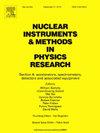Measurement of β-particles to determine cross sections relevant to the weak r-process
IF 1.5
3区 物理与天体物理
Q3 INSTRUMENTS & INSTRUMENTATION
Nuclear Instruments & Methods in Physics Research Section A-accelerators Spectrometers Detectors and Associated Equipment
Pub Date : 2025-02-02
DOI:10.1016/j.nima.2025.170272
引用次数: 0
Abstract
The neutron-rich isotopes with 30 Z 45 are thought to be synthesized in neutrino-driven winds after the collapse of a massive star. This nucleosynthesis scenario, called the weak r-process, is studied using nuclear reaction network calculations. The accuracy of the nucleosynthesis simulations is strongly influenced by the reliability of the nuclear physics input parameters used. Recently, it has been demonstrated that (,n) reactions play a particularly important role in the weak r-process, but their rates – computed from the cross sections – are only known with large uncertainties in the astrophysically relevant temperature range. The half-lives of the products of some key reactions are such that, in principle, the cross sections can be studied using the activation technique. In many cases, however, the -decay of the reaction products leads to the ground state of the daughter nucleus, hence no gamma emission occurs. The purpose of this manuscript is to present our setup with which we determine the cross sections by measuring the yield of -particles emitted during radioactive decay. The 86Kr(,n)89Sr reaction cross-section measurement is used, as a case study.
求助全文
约1分钟内获得全文
求助全文
来源期刊
CiteScore
3.20
自引率
21.40%
发文量
787
审稿时长
1 months
期刊介绍:
Section A of Nuclear Instruments and Methods in Physics Research publishes papers on design, manufacturing and performance of scientific instruments with an emphasis on large scale facilities. This includes the development of particle accelerators, ion sources, beam transport systems and target arrangements as well as the use of secondary phenomena such as synchrotron radiation and free electron lasers. It also includes all types of instrumentation for the detection and spectrometry of radiations from high energy processes and nuclear decays, as well as instrumentation for experiments at nuclear reactors. Specialized electronics for nuclear and other types of spectrometry as well as computerization of measurements and control systems in this area also find their place in the A section.
Theoretical as well as experimental papers are accepted.

 求助内容:
求助内容: 应助结果提醒方式:
应助结果提醒方式:


